by Winding Pathways | Aug 15, 2014 | Nature, Trees/Shrubs
We are lucky to have four species of oak trees on our property. Huge white oaks hug the north end with a few red oaks scattered between them. Two medium sized black oaks live close to the house and a young bur oak is just beginning to cast shade south of the house.
Millions of other homeowners are also fortunate to have oaks shading their property. They are one of the most widespread trees, and are beautiful, sturdy, valued by wildlife and long lived. A white oak could shade the ground and feed squirrels for up to 400 years. Some species, like red oaks, grow relatively quickly and tolerate moderate shade while most other oaks, like our bur, need full sun and grow slowly.
About 600 oak species are found naturally across the northern hemisphere. Approximately 90 species live in the United States. China boasts around 100 species, and Mexico is probably the world leader in oak diversity with at least 160 species. They have been widely planted in temperate regions including many places where they don’t occur naturally.
Oaks are members of the beech family with the genus name Quercus. It’s rather easy to distinguish an oak tree, but determining just what oak species a tree belongs to can be tricky. Many oaks hybridize with similar oak species and a tree may have characteristics of each parent. Sometimes the shape of an oak leaf near the top of a tree may be shaped differently from a counterpart lower down.
Non-showy oaks flower in mid spring about the time leaves appear. Male blooms are slim, drooping and green or tan in color. Each female flower is a solitary spike. People allergic to the wind borne pollen generally suffer in the spring.
Throughout history oak wood has been readily used by people. Even wine corks are made from the bark of Portuguese oaks. Oak was widely used in the construction of sailing ships. It’s said that the oak sides of the USS Constitution were so tough that British cannonballs bounced back. That’s where the nickname Old Ironsides came from! Oak is the traditional wood for liquor aging barrels but today it is most commonly used for hardwood flooring and furniture. Few woods produce more fireplace heat than oak.
Squirrels are just one of the wildlife species that love acorns. Among the host of other wild animals that relish acorns are deer, bears, woodchucks, wild turkeys and blue jays. However, oak leaves or acorns can be toxic to cows that eat too many. Tannin is the bitter element in oaks and acorns and long ago humans learned how to remove it to create delicious food. Each fall we look forward to harvesting acorns. Few foods are as delicious as maple syrup on warm acorn muffins.
Subscribe to Winding Pathways to learn how to process acorns into food.
For further Information
One of the most fascinating tree books ever written was published back in 1948. It is a two volume set by David Culross Perry. One volume covers trees of eastern North America while its counterpart describes western species. If you spot it for sale at a garage or used book sale snap it up.
Websites, apps and books abound that help identify and learn about trees. Our favorite websites are from the National Arbor Day Foundation at and the US Forest Service. Our favorite tree identification book is the Sibley Guide to Trees.
by Winding Pathways | Oct 26, 2023 | (Sub)Urban Homesteading, Garden/Yard, Nature, Trees
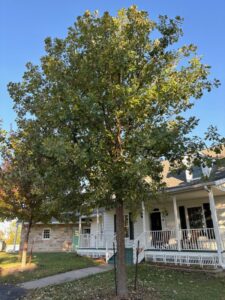
Magnet bur oak in front yard
We didn’t intend to create a magnet when we planted a skinny bur oak in our front yard 13 years ago.
It created a startling experience one October evening when Marion went to the porch to check the weather. A large furry form dropped from the nearby tree and scurried away in the gathering darkness. A woodchuck? Not likely. They work the day shift. Later we caught the mystery animal in the bean of a flashlight as it returned to the magnet tree. A husky raccoon that again retreated in haste when it saw us.
Over the next several days we watched squirrels and woodchucks forage on the acorns. At dusk bucks and does with yearlings eagerly, yet watchfully, gobbled up acorns. In between, turkeys wandered by to forage. Blue jays dropped out of the tree onto the ground and carried off husky acorns to store for winter.
Why Oaks Attract Wildlife
Our October oak was a perfect magnet. While most area oaks were acorn-bare, our youthful front yard tree was loaded with them. They were huge, sweet, and free of the weevils that often consume acorns before exiting through tiny holes.
Blue jays, wild turkeys, woodchucks, raccoons, squirrels, and deer consider October acorns prime carbohydrate-loaded food. When few oaks, scattered around, bear a heavy crop, wild animals beeline to those loaded with nuts. That’s why our tree was a magnet drawing in a stream of wildlife until every acorn was consumed.
-
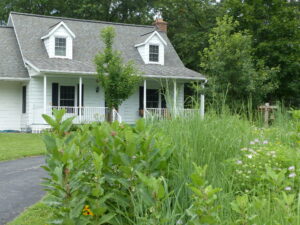
-
Small oak and maple.
-
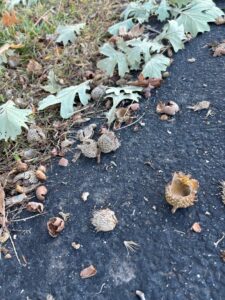
-
Prolific Bur Oak acorns
-
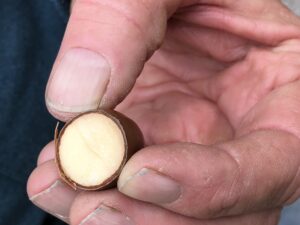
-
White oak acorns have lower tannic acid.
White oak types have leaves with rounded lobes. These include white, bur, and swamp white oaks. Their big acorns are low in tannic acid and are a prized animal and human food. Most trees only bear a heavy crop every few years with acorns that sprout almost as soon as they hit the ground. If not eaten soon weevils find them.
Black oak types have leaves with pointed lobes. Their acorns are loaded with bitter tannin. Often wild animals only feast on them after nearby sweeter white oak-type acorns have all been eaten. Black oak-type acorns wait until next spring to sprout. Perhaps their tannic acid helps them remain uneaten until they sprout months after falling from the tree.
Optimal Places to Plant Oaks
When planted in an ideal location with full sun and rich soil, an oak will begin producing acorns when it’s seven to ten years old. Our front yard tree had a light crop the past few years, but when it reached its 13th year it was loaded with nuts. It was a true magnet that lured wildlife in from far and wide. We enjoyed watching many animals dine on acorns produced by a tree we planted.
by Winding Pathways | Aug 10, 2023 | Mammals, Nature, Trees/Shrubs
Squirrels: Free Tree Planters
Our neighborhood squirrels proved they are the best tree planters.
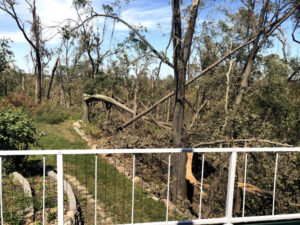
We lost most of our mature trees in the 2020 Derecho.
An August 2020 derecho tore through Iowa pushing 140-mile-an-hour wind against trees and buildings. Trees by the hundreds of thousands tumbled to the ground. Winding Pathways wasn’t spared. We lost most of our firs, oaks, hickories, and cottonwoods. The devastation in nearby Faulkes Heritage Woods was even worse.
Almost immediately, shocked people took action. Government forestry departments, aided by tree planting nonprofits, and private citizens unleashed their shovels and planted thousands of trees. So did the squirrels. Well, not really. People planted trees.
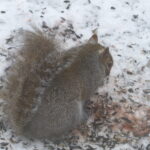
Squirrels bury nuts in caches to retrieve them later.
Squirrels planted nuts and acorns.
Then three seasons of drought followed. Once planted, most trees were not tended as they need to be. So, many human-planted trees shriveled in the heat and dryness, while the nuts buried by squirrels sprouted and the new trees were flourishing.
But why?
We have theories. A human-planted tree seedling needs plenty of moisture to keep its trunk and new leaves hydrated. Sparse roots must pull water from the ground and send it upward. That’s a tough job in a wet year. Come drought it’s nearly impossible.
Squirrels did better. These industrious rodents don’t mean to create new trees. They’re simply storing nuts underground so they have enough fat and protein-rich food to tide them through winter. All they need to do is dig up a nut when hunger calls. Squirrels overfill their larder, burying more tasty nuts than they’ll ever need. Unfortunate squirrels are eaten by hawks, foxes, owls, or humans, but the nuts they’d buried remain patiently waiting for spring’s warmth to germinate.
Sprouting nuts grow roots able to pull scarce moisture from the soil and send it to new baby leaves poking through the ground.
As we walked through July 2023’s dry woods we sadly see human-planted trees shriveled up and dead, while nearby a new generation of tiny walnut, oak, and hickories is rising from nuts planted by industrious squirrels.
-
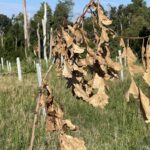
-
Newly planted trees need watering.
-
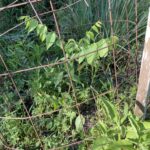
-
This squirrel planted walnut seedling sprouted just this year in spite of the drought.
Squirrels Don’t Plant All The Trees
Squirrels are the best friends of nut-bearing trees, but other tree species can’t rely on the furry rodents. Cottonwoods, for example, produce millions of seeds too tiny for squirrel food. So, the trees grow cottony fluff that floats seeds to distant places. If one lands in a patch of moist bear soil a fast-growing cottonwood sprouts. Maples have helicopter-like seeds that whirl a gig away from the parent to sprout a ways away.
Pity the poor Osage Orange tree that grows huge citrus-smelling balls containing hidden seeds. Many folks call them hedge apples. A tree must get its seeds away from its own shade. Squirrels do the job for oaks. The wind for cottonwoods. Massive mastodons once munched on Osage Orange hedge apples, wandered off, digested the pulp, and pooped out the seeds. When these massive elephants went extinct the tree lost its partner and saw its native range shrink from much of North America to a tiny spot down south.
Nature provides many ways for trees to reproduce and the results are often superior to what humans can do. We appreciate the squirrels that plant nuts many of which sprout into healthy native trees. Thanks, squirrels!
by Winding Pathways | Jan 12, 2023 | Nature, Trees
Winter trees. We love ‘em even though they don’t sport their cooling green summer leaves or October’s color.
When autumn leaves fall, trees look wonderfully different. Their nakedness reveals sights that are difficult to notice during summer. Here are some of the delights we discover when walking through January woodlands and looking at the winter trees.
Pods, Seeds, Textures
Pods and Seeds: Just what are those long string bean-looking pods hanging from the branches? They are the seed pods of the catalpa tree. Nearby are flattish, twisted, crinkled black pods upwards of six inches long. Some are still hanging from branches, while others litter the path. They’re honey locust pods. Pry one open to find large black seeds inside. Box elders have typical maple helicopter seeds that stay on the trees much of the winter unless devoured by hungry squirrels or cardinals. Sycamore trees hold their round ball seeds on the ends of branches well into winter.
Twig Texture: Elms and sugar maples sport zillions of finely textured twigs toward their tops, while walnuts, box elders, catalpas, and ailanthus have far fewer but much thicker twigs. Ash trees are somewhat in between, but their twigs radiate out at nearly right angles from branches.
-
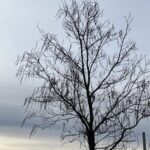
-
Catalpa pods hang on through the winter.
-
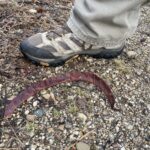
-
Pod next to size 12 foot.
-
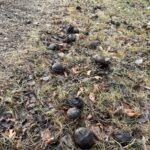
-
When you see walnuts look up and note the structure of the tree.
-
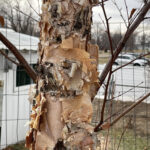
-
River Birch bark curls.
Bark and Shape
Bark: Young maples, ailanthus, and Siberian elms have smooth bark that becomes darker and more textured as the tree grows. The most intriguing bark pattern is always on hackberry trees. The bumpy bark makes it unmistakable.
Shape: The profile of leafless trees often is a clue to the species. Pin oaks have a central trunk with lower branches that sometimes slope downward or radiate out at nearly right angles. The tree is spruce shaped in great contrast to wide-spreading white and bur oaks. Box elders always seem to be leaning one way or another, while American elms often show a thick buttress close to the ground beneath a vase-shaped upper. Siberian elms shoot straight for the sky.
-
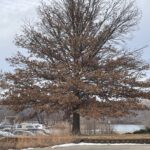
-
Pin oaks hold leaves.
-
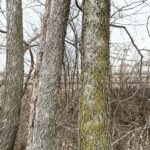
-
The knobby bark of the Hackberry reminds us of fat tires!
-
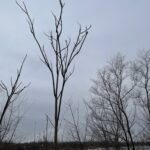
-
Ailanthus coarse twigs and finer twigging of Siberian Elm
Color
Color: Although winter tree bark is mostly gray to black sometimes color comes through. Spot a subtle orange bark and it’s likely a mulberry tree. Large Scotch pines also have pumpkin-colored bark towards the top. Sycamores are distinctive in their pale, flakey bark. And, white birches are easy to identify with their smoother, white bark that tends to curl as the trees age. Their cousin, the river birch, has shaggier bark and often grows larger in damp soil.
Winter trees are always fun to see and often are easy to identify. As we walk through the snow, we love discovering many tree shapes, textures, seeds, and bark. to help identify Google something like shape of (name of tree) in winter. The images will help you identify the trees before you go for a walk.
by Winding Pathways | Sep 23, 2021 | (Sub)Urban Homesteading, Garden/Yard, Nature, Trees
Coppicing
What? Coppicing? That word almost sounds dirty. Well, it’s not. It is a good way to help derecho doomed trees live on!
We recently hosted friends to mark the first anniversary of the August 10, 2020, furious derecho that leveled around 70% of trees in the Cedar Rapids area.
Many people used words like devastation and destruction to describe what happened to trees in both forests and neighborhoods. The damage was truly shocking.
-
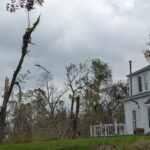
-
Trimming damaged trees.
-
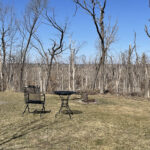
-
All winter we looked on broken trees.
-
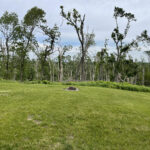
-
Springing Back from Derecho.
The Giving Trees
We wanted to show visitors a miracle of nature stimulated by the storm. Just east of our house stood a couple of basswood trees. Few of nature’s scents are as delightful as what comes from the blooms of this tree. Bees will fly three miles away to gather the nectar. We just enjoy the scent.
Basswoods have a problem. Their wood is soft and weak. When the derecho hit, they quickly snapped off, leaving a tangle of branches in our yard. Nearly a year later they demonstrated the power of near-perpetual youth.
-
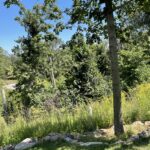
-
In the middle our basswood looks like a fuzzy brush.
-
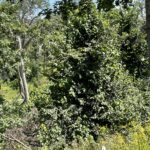
-
This basswood wants to live!
Basswoods, along with many other deciduous trees, readily coppice. If a tree is cut or blown down it sends shoots up from the stump. Our basswoods quickly sprouted this spring, and we’re seeing others sprouting from stumps in suburban yards. Many species of deciduous trees also send up shoots. Ashes, oaks, and honey locusts are common sprouters. Evergreens don’t. If a pine or spruce is cut off, the stump dies.
Woodland Management
In Europe coppicing is a method of woodland management. A tree is cut down and allowed to resprout. Because the regrowth is coming from a well-established root system, sprouts grow like crazy. The sprouts are managed carefully. The most hearty sprout is kept and the others cut off. Within five to twenty years, or so, the hearty sprout is big enough to cut for firewood, fence posts, or walking sticks. Then the stump resprouts again. Some trees have been coppiced for hundreds of years.
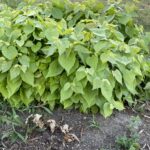
Basswood trees are champion sprouters. Our stumps now look like balls of green leaves from all the sprouts radiating from the stumps. This fall we’ll clip off all but the most vigorous one. It will quickly form a new tree. That’s better, easier and cheaper than grubbing out the stump, then buying and planting a replacement tree.
-
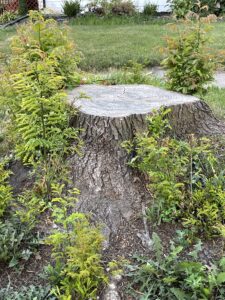
-
The Giving Tree
-
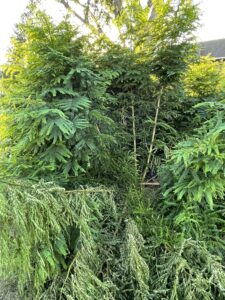
-
A look at the stems of new sprouts
-
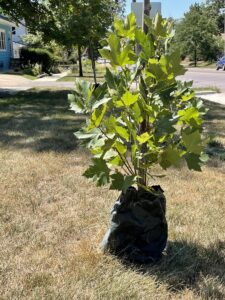
-
the original new tree died, but sprouted from the bottom.
-
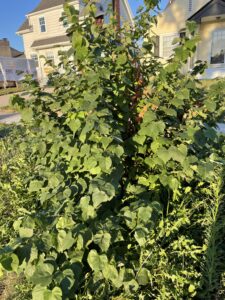
-
Repairs continue as damaged trees sprout.
An Internet search will turn up much information on coppicing. We like the website of the Midwest Permaculture Center.

























